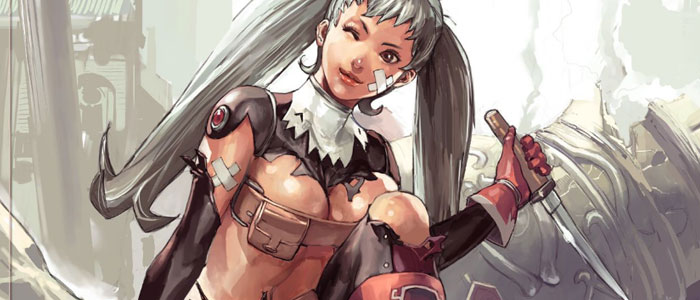I like Atlus. I like their quirks and their weird taste; when they’re at the top of their game, we get gems like the Etrian Odyssey, Tactics Ogre, and Persona series, Knights in the Nightmare, and Izuna. Even their misfires are usually entertaining (Super Robot Taisen OG Saga: Endless Frontier), and when Atlus games are bad, they’re at least unique (Dark Spire). They publish games that you wouldn’t find anywhere else, and lately they’ve been publishing a lot of good ones. It’s regrettable, then, that Steal Princess commits the banal crime of mediocrity. It’s not particularly bad, but it fails wholly to be anything good.
The opening blasts you with a fun piece of J-pop and a montage of goth-loli imagery showing you how badass our heroine Anise is; then a blocky animation of her essaying the Demon Palace, falling into a classic rolling boulder trap, and narrowly escaping. Kukri, a fairy named, one assumes, after the distinctive Nepalese knife, rescues her and takes her back to Albyon Castle, where she is mistaken for the legendary Hero and tasked with rescuing the Prince, held captive in the demon castle.
Anise, who features a missing eye and a nigh-prehensile whip, must puzzle her way through six different zones, each comprised of numerous maps. Each map gives you a different objective – though it’s almost always “Defeat all enemies!” – that must be completed to move on. You can collect swords, spears, shields, and even different elemental types of these (“rock sword”), though they may as well call them “rock, paper, scissors”. Kill the fire kobold with a fire sword; he drops a rock sword, which you can then use to kill a rock kobold.
This is representative of the game’s design philosophy. Puzzles don’t require creative or critical thinking, but persistence and trial and error. As you progress, the puzzles get more complicated, but not more challenging – merely more tedious. Since most of the puzzles involve killing enemies in the proper order, you get the impression that the monotony and rigidity of thought evident in the puzzles invades the combat mechanics. You swing a sword; the enemy reacts with the alacrity of a Xi’an clay warrior. Every once in a while you get a boss fight that might require an additional mechanic; whip the enemy, then switch weapons and attack. Slightly more fun than reorganizing a card catalog, but not as cheap.
When the game attempts 3D, in the enemies and landscapes, the results are muddy and unattractive. The 2D stills used for narration are quite good, though, and provide most of the game’s charm.
“Charm,” in fact, is the game’s main redeeming factor. There’s a lot of dialogue between levels; some of it is “funny,” and some is genuinely funny – for example, an ogreish demon who speaks in grunts but is subtitled with heartfelt, complex sentences. The interplay between Anise and Kukri, who floats around the top screen dispensing non-advice, is occasionally worth a chuckle. Sometimes, a groan, too often, a “Shut the hell up, you stupid fairy!”
The controls are stiff and the platforming floaty. Combat is rarely difficult, but there’s enough platforming that Anise’s loose, featherlike jumps will accidentally kill you more often than not. Deaths from challenge are acceptable; deaths from poor controls are not. Several times I would throw the final, crucial bomb in the wrong direction because I couldn’t get Anise to face the right way, and have to restart.
Most of the maps can be completed in under a minute and almost all of them in fewer than two. You can feel free to replay them and try to improve your time to snare medals, but they don’t unlock anything except satisfaction, and they exact a heavy toll in sanity. When you’re done, a map editor will let you design your own levels and trade them via wireless, an uncommon and welcome feature on a DS game. If only it were attached to something worth playing.
